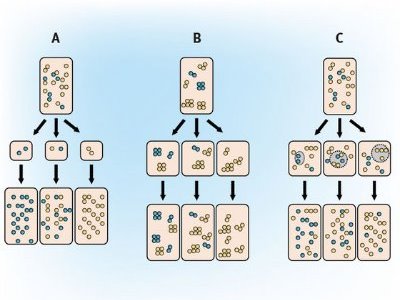Apr. 25, 2007 Research Highlight Biology
Narrowing bottleneck theories
Commonly accepted theory on mitochondria transmission ruled out
 Figure 1: Three models for rapid mtDNA segregation during cell division in female mouse reproductive (germ) cells: (a) model A—reduction in the number of mtDNA copies; (b) model B—clumping together of like variants; and (c) model C—replication of sub-groups. © Nature Genetics/Nature Publishing Group/39/387 (2007)
Figure 1: Three models for rapid mtDNA segregation during cell division in female mouse reproductive (germ) cells: (a) model A—reduction in the number of mtDNA copies; (b) model B—clumping together of like variants; and (c) model C—replication of sub-groups. © Nature Genetics/Nature Publishing Group/39/387 (2007)
Researchers from the RIKEN BioResource Center in Tsukuba, the Tokyo Metropolitan Institute of Medical Science and two Japanese universities have ruled out one of the leading hypotheses as to how mutations in mitochondrial DNA (mtDNA) can become incorporated into the genome in just a few generations. The finding is an important step towards understanding the dynamics of mitochondrial genetic disease and predicting the risk of its occurrence in children.
Mitochondria are membrane complexes which serve as the energy production centers of cells. Any disruption to their function can cause serious illness. In mammals, mitochondria are inherited only from the mother. They carry their own DNA which has a higher mutation rate than the DNA in the nucleus.
Because of the high mutation rate, there are a large number of variants of mtDNA in any population. Most individuals, however, tend only to have one variant, which implies that variants are either accepted or rejected within a few generations. This observation has led to the suggestion that during mammalian development the mitochondria pass through a ‘bottleneck’ stage whereby the statistical chances of one competing variant becoming dominant are increased.
There are three different models as to how this could happen (Fig. 1). Two of them propose that at some point in development only a small number of mtDNA segregation units are involved in transmission, increasing the chances that different variants will be sorted unequally into daughter cells during cell division. This could occur if there were a large reduction in the total number of copies of mtDNA in cells (model A, Fig. 1a) or if like variants tended to clump together and were sorted as fewer units (model B, Fig. 1b). The third model proposes that copies of mtDNA in a small region of the cell replicate massively after cell division (model C, Fig. 1c).
In a recent paper in Nature Genetics1, the researchers describe how they traced the mtDNA content of the cells which become germ cells in female mice during the first 13.5 days of development. They determined that the number of copies of mtDNA per cell never fell to a level that would make model A possible. In comparison, the mtDNA content of non-germ cells of the same age varied much more widely, and at times fell to much lower levels. This leaves only models B and C as possible explanations.
“Having ruled out the most commonly accepted theory of transmission,” says lead author, Liqin Cao, “we now want to nail down exactly what is happening using in vivo imaging.”
References
- 1. Cao, L., Shitara, H., Horii, T., Nagao, Y., Imai, H., Abe, K., Hara, T., Hayashi, J-I. & Yonekawa, H. The mitochondrial bottleneck occurs without reduction of mtDNA content in female mouse germ cells. Nature Genetics 39, 386–390 (2007). doi: 10.1038/ng1970
